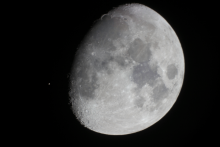Listen to today's episode of StarDate on the web the same day it airs in high-quality streaming audio without any extra ads or announcements. Choose a $8 one-month pass, or listen every day for a year for just $30.
You are here
Moon and Aldebaran
When you look at pictures of the Sun, you see a fairly sharp edge, as though the Sun has a solid surface. But that’s not the case at all. Hot gas outside that surface extends many thousands of miles into space. It’s so thinly spread, though, that we can see right through it. What we see as the surface is the point where the gas is so dense that we can’t see through it to the layers below.
For some other stars, though, it’s harder to make out any surface at all. The star is surrounded by so much gas that it’s as though it was enveloped by a glowing fog.
An example is Aldebaran, the brightest star of Taurus the bull. The bright orange star is quite close to the Moon as darkness falls tonight.
Aldebaran is a red giant — a star that’s nearing the end of its life. It’s converted the original hydrogen in its core to helium. The helium can’t “fuse” together to produce energy, so the core is shrinking and getting hotter. That’s triggered nuclear reactions in a shell of hydrogen around the core.
The heat from the “burning” hydrogen, and from the helium core, pushes outward on the layers of gas above them. That’s caused Aldebaran to puff up to dozens of times its original size. The gas at the surface of the star is quite thin. And a good bit of it is blowing out into space in the form of a strong wind. That surrounds the star with a spray of hot gas that makes it hard to see any “surface” at all — giving Aldebaran a “fuzzy” appearance.
Script by Damond Benningfield




